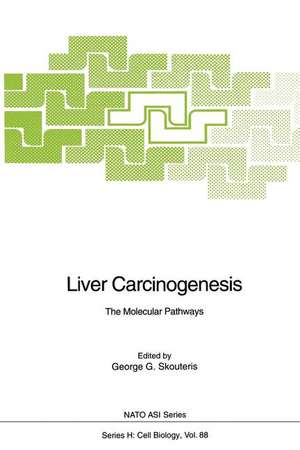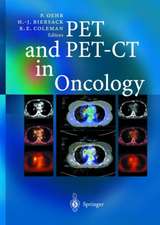Liver Carcinogenesis: The Molecular Pathways: Nato ASI Subseries H:, cartea 88
Editat de George G. Skouterisen Limba Engleză Paperback – 27 dec 2011
Din seria Nato ASI Subseries H:
- 18%
 Preț: 953.82 lei
Preț: 953.82 lei -
 Preț: 393.13 lei
Preț: 393.13 lei - 15%
 Preț: 643.34 lei
Preț: 643.34 lei - 15%
 Preț: 643.34 lei
Preț: 643.34 lei - 15%
 Preț: 641.03 lei
Preț: 641.03 lei - 15%
 Preț: 642.83 lei
Preț: 642.83 lei - 15%
 Preț: 642.51 lei
Preț: 642.51 lei - 5%
 Preț: 712.81 lei
Preț: 712.81 lei -
 Preț: 392.97 lei
Preț: 392.97 lei - 15%
 Preț: 651.02 lei
Preț: 651.02 lei - 15%
 Preț: 640.24 lei
Preț: 640.24 lei - 18%
 Preț: 948.61 lei
Preț: 948.61 lei - 15%
 Preț: 655.92 lei
Preț: 655.92 lei - 15%
 Preț: 655.92 lei
Preț: 655.92 lei - 15%
 Preț: 653.14 lei
Preț: 653.14 lei - 15%
 Preț: 650.19 lei
Preț: 650.19 lei - 15%
 Preț: 655.13 lei
Preț: 655.13 lei - 15%
 Preț: 652.17 lei
Preț: 652.17 lei - 15%
 Preț: 675.58 lei
Preț: 675.58 lei - 18%
 Preț: 958.07 lei
Preț: 958.07 lei - 18%
 Preț: 961.41 lei
Preț: 961.41 lei - 18%
 Preț: 970.56 lei
Preț: 970.56 lei - 5%
 Preț: 1100.30 lei
Preț: 1100.30 lei - 5%
 Preț: 376.43 lei
Preț: 376.43 lei - 15%
 Preț: 650.86 lei
Preț: 650.86 lei - 15%
 Preț: 644.63 lei
Preț: 644.63 lei - 15%
 Preț: 655.60 lei
Preț: 655.60 lei - 18%
 Preț: 963.47 lei
Preț: 963.47 lei - 15%
 Preț: 648.42 lei
Preț: 648.42 lei - 5%
 Preț: 731.43 lei
Preț: 731.43 lei - 15%
 Preț: 653.14 lei
Preț: 653.14 lei - 18%
 Preț: 960.13 lei
Preț: 960.13 lei - 18%
 Preț: 968.34 lei
Preț: 968.34 lei - 18%
 Preț: 953.97 lei
Preț: 953.97 lei - 15%
 Preț: 654.95 lei
Preț: 654.95 lei - 15%
 Preț: 652.49 lei
Preț: 652.49 lei - 15%
 Preț: 650.86 lei
Preț: 650.86 lei - 5%
 Preț: 367.64 lei
Preț: 367.64 lei - 5%
 Preț: 1104.68 lei
Preț: 1104.68 lei - 18%
 Preț: 953.20 lei
Preț: 953.20 lei - 15%
 Preț: 651.99 lei
Preț: 651.99 lei - 15%
 Preț: 647.27 lei
Preț: 647.27 lei - 15%
 Preț: 653.00 lei
Preț: 653.00 lei - 15%
 Preț: 656.25 lei
Preț: 656.25 lei - 18%
 Preț: 962.35 lei
Preț: 962.35 lei - 15%
 Preț: 644.82 lei
Preț: 644.82 lei - 15%
 Preț: 666.55 lei
Preț: 666.55 lei - 15%
 Preț: 642.68 lei
Preț: 642.68 lei - 15%
 Preț: 645.96 lei
Preț: 645.96 lei - 15%
 Preț: 651.84 lei
Preț: 651.84 lei
Preț: 727.80 lei
Preț vechi: 766.10 lei
-5% Nou
Puncte Express: 1092
Preț estimativ în valută:
139.26€ • 145.12$ • 115.31£
139.26€ • 145.12$ • 115.31£
Carte tipărită la comandă
Livrare economică 03-17 aprilie
Preluare comenzi: 021 569.72.76
Specificații
ISBN-13: 9783642792175
ISBN-10: 3642792170
Pagini: 516
Ilustrații: XIX, 483 p.
Dimensiuni: 155 x 235 x 27 mm
Greutate: 0.72 kg
Ediția:Softcover reprint of the original 1st ed. 1994
Editura: Springer Berlin, Heidelberg
Colecția Springer
Seria Nato ASI Subseries H:
Locul publicării:Berlin, Heidelberg, Germany
ISBN-10: 3642792170
Pagini: 516
Ilustrații: XIX, 483 p.
Dimensiuni: 155 x 235 x 27 mm
Greutate: 0.72 kg
Ediția:Softcover reprint of the original 1st ed. 1994
Editura: Springer Berlin, Heidelberg
Colecția Springer
Seria Nato ASI Subseries H:
Locul publicării:Berlin, Heidelberg, Germany
Public țintă
ResearchCuprins
Molecular pathways in hepatocyte proliferation.- HGF and liver growth regulation.- Structure, pleiotropic actions and organotrophic roles of hepatocyte growth factor.- Hepatocyte Growth Factor and its variant with a deletion of five amino-acids are distinguishable in biological, physicochemical and immunochemical properties.- Growth stimulation mediated by G protein-coupled receptors in hepatocytes: Synergism with epidermal growth factor and mechanisms of signal transduction.- Protein tyrosine phosphatases in signal transduction.- C-myc is essential for initiation of DNA synthesis in EGF-stimulated hepatocyte cultures.- Cellular biology of the rat hepatic stem cell compartment.- Changes in protein expression during oval cell proliferation in the liver.- Stem cell activation in the acetylaminofluorene-treated regenerating rat liver: A bile ductular reaction?.- Apoptosis and its role in hepatic carcinogenesis by non-genotoxic agents.- Cell proliferation and cell death in the liver: Patterns, mechanisms and measurements.- Preneoplastic changes during non-genotoxic hepatocarcinogenesis.- mRNA composition of rat liver tumors initiated by aromatic amines.- Liver ?-Glutamyl transpeptidase activity after cyclosporine A and amlodipine treatment.- Enhanced expression of the 27KDa heat-shock protein during DENA-induced hepatocarcinogenesis in rat and in human neoplastic and non-neoplastic liver tissues.- Hepatic recovery of dimethylnitrosamine-cirrhotic rats after injection of the liver growth factor.- Cell contact-mediated regulation of hepatocyte differentiation/proliferation: Role of LRP(s).- Interactions of human hepatocytes with hepatitis B virus.- Liver-specific aspects of hepatitis B virus gene expression.- Transcriptional involvement of the hepatitis B virus protein incellular transduction systems. Protein-protein interactions with bZip transactivators.- Role of duck hepatitis B virus infection, aflatoxin B1 and p53 mutation in hepatocellular carcinomas of ducks.- The preparation and culturing of rat hepatocytes.- Isolation and growth of hepatocytes and biliary epithelial cells from normal and diseased human livers.- A novel strategy for isolating HEPR, a human small intestinal cytidine deaminase.- Regenerating liver: Isolation of up- and down-regulated gene products.- Hepatotrophic and renotrophic activities of HGF in vivo: Possible application of HGF for hepatic and renal diseases.- Targeted gene delivery and expression.- Studies on persistence and enhancement of targeted gene expression.- The generation of tumor vaccines by adenovirus-enhanced transferrinfection of cytokine genes into tumor cells.













